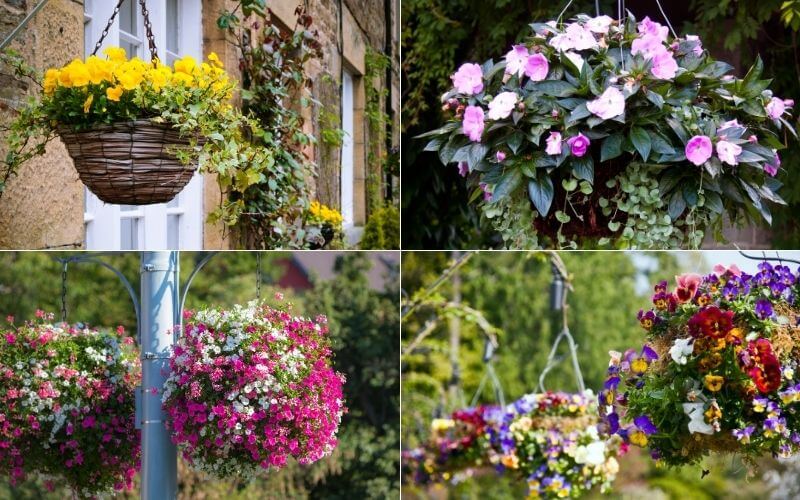
Nothing is more delightful than those cascades of colors and flowers that hang above our heads in baskets, like “small gardens floating in the sky”.
From window boxes to urban street decoration, hanging baskets’ popularity is growing, also thanks to new and often environmentally friendly containers, but above all thanks to the beauty of trailing, draping and great flowers to grow in them.
There are many flowers you can grow in hanging baskets; most are trailing plants, but not all, and, of course, you will need plants of a comparatively small size. From petunias to orchid cactus, however, the choice is vast, as is the palette of colors and shapes of the flowers.
Do you have a hanging basket in mind, maybe for your terrace or even for an indoor space?
If you have not decided which hanging flowers will suit you best, in this article you will find some of the best flowers for your hanging baskets, with pictures, descriptions and as well as practical tips.
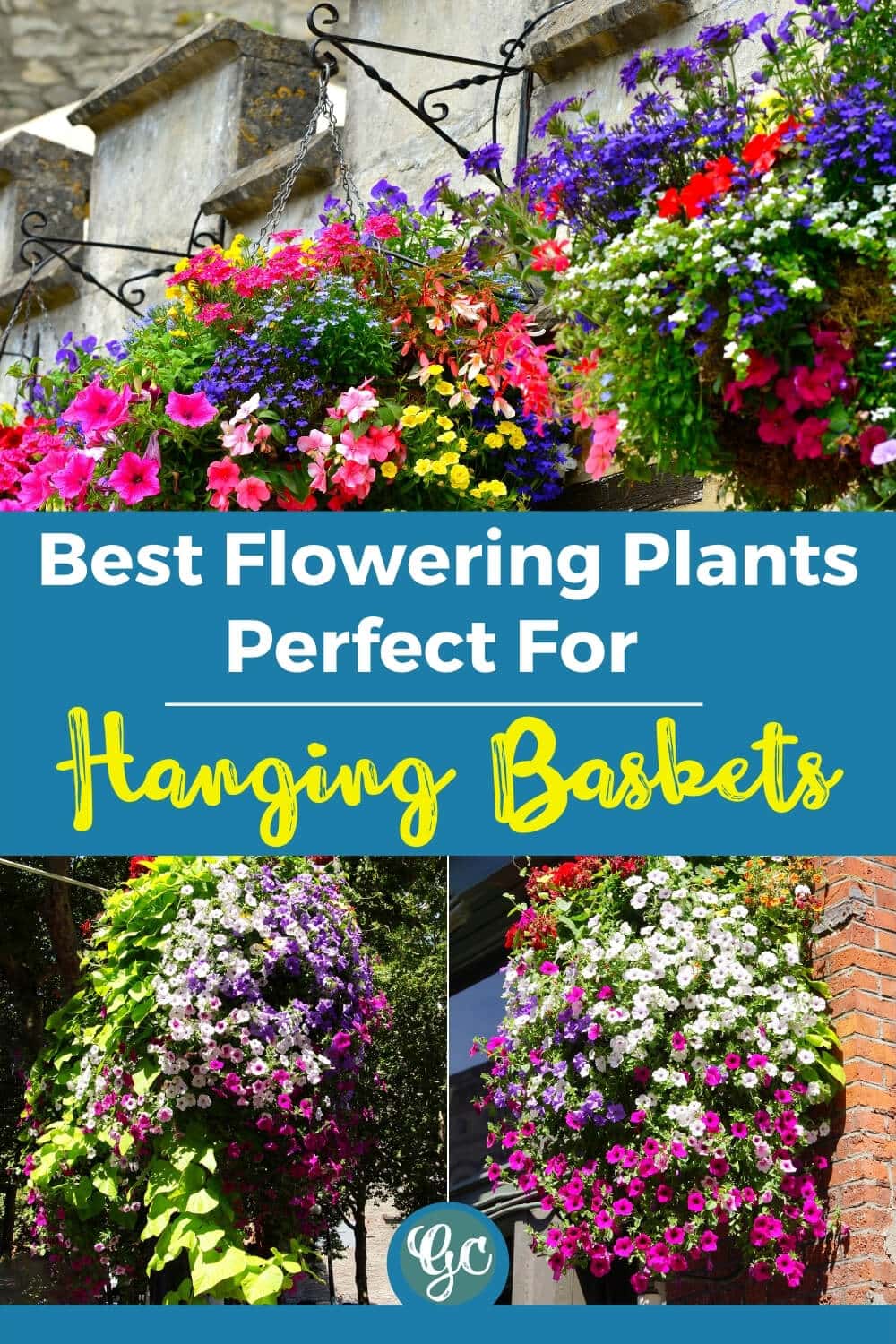
The Best 15 Flowers for Hanging Baskets
Of the flowers you can grow in hanging baskets, some are really extraordinary, as they will give you so many flowers for so long, and such beautiful flowers that your containers will look like works of art.
Here are 15 of the best flowers for hanging baskets for adding color and interest to your balcony or small space garden.
1. Petunias (Petunia Spp.)
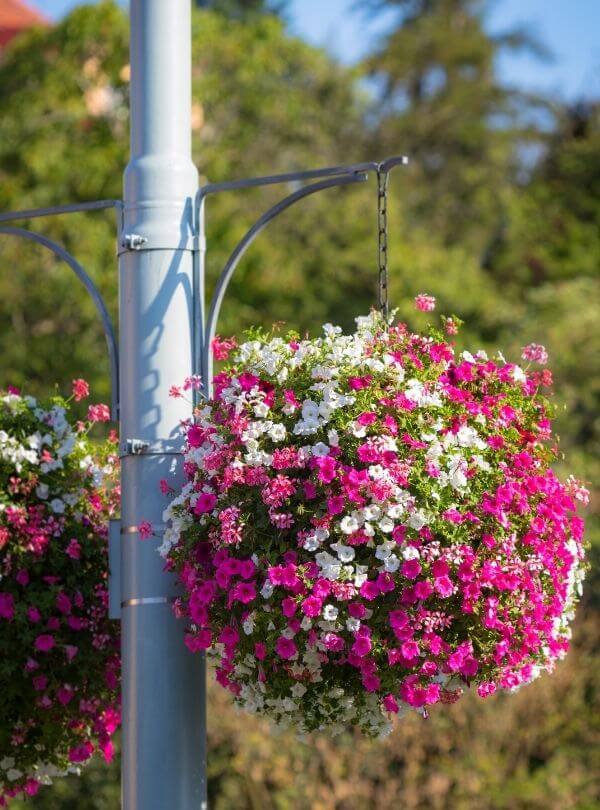
The “queen of hanging baskets”, petunia is a very generous plant, easy to grow and an impressive bloomer! It is arguably the favorite flower for hanging baskets in public places, like pubs or lamp posts, and it has been decirating window sills all over the world for for a long time now.
With its showy cascade of large, brighlty colored flowers that form a velvety tapestry of energy and life, this plant’s blossoms can last from late spring well into fall.
You can either grow it as an annual or a perennial, depending on the climate, and therre are so many varieties, literally of all colors and combinations, that the choice is brathtaking.
They are also very suitable for hanging baskets because they are drought and heat resistant, and there are some famous cultivars and varieties, like the yellow and white ‘Shock Wave Yellow’, the romantic peach colored ‘Bermuda Beach’, the classically purple ‘Easy Wave Violet’, the elegant ‘Tidal Wave Silver’, white with thin purple veins, or the very unusual ‘Supertunia Picasso in Purple’ which is magenta with green tips…
2. Ivy Geranium (Pelargonium Peltatum)
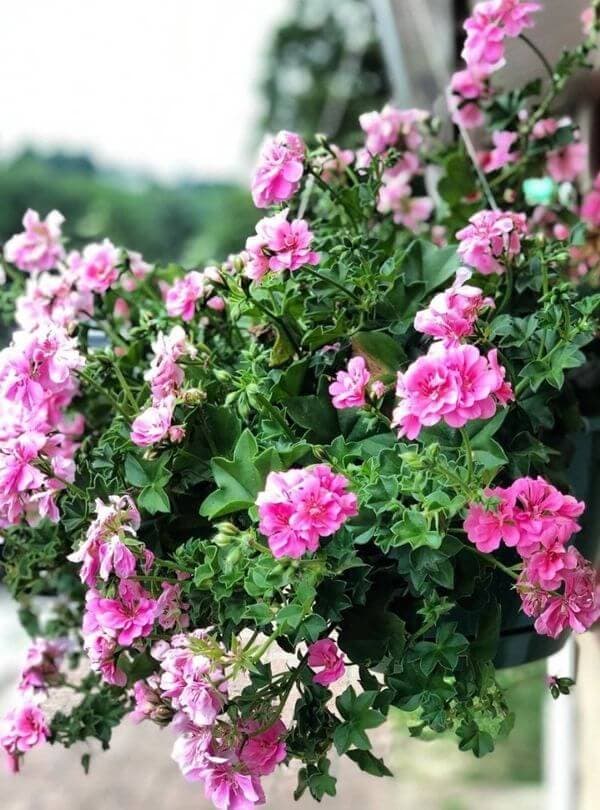
If you travel the Alps, you will notice that virtually every window has a colorful box of geraniums…
There are many species you can grow in hanging baskets, and this one, ivy geranium, offers a wide range of colors, from white to purple via pink and rose, either with elegant thin-petaled flowers, or with more conspicuous double flowers.
So, ‘Cascade Acapulco Compact’ has the deepest and warmest pink you can imagine, while ‘Cascade White’ offers you the candor of snow with purple veins towards the center if the flower…
These trailing evergreen perennials are very persistent bloomers too, and they will fill your baskets with flowers from late spring to the first frost and all through the summer months.
By the way, one of the reasons why they grow them on the windows of alpine cottages is that they keep mosquitoes out…
3. Fuchsia (Fuchsia Spp.)
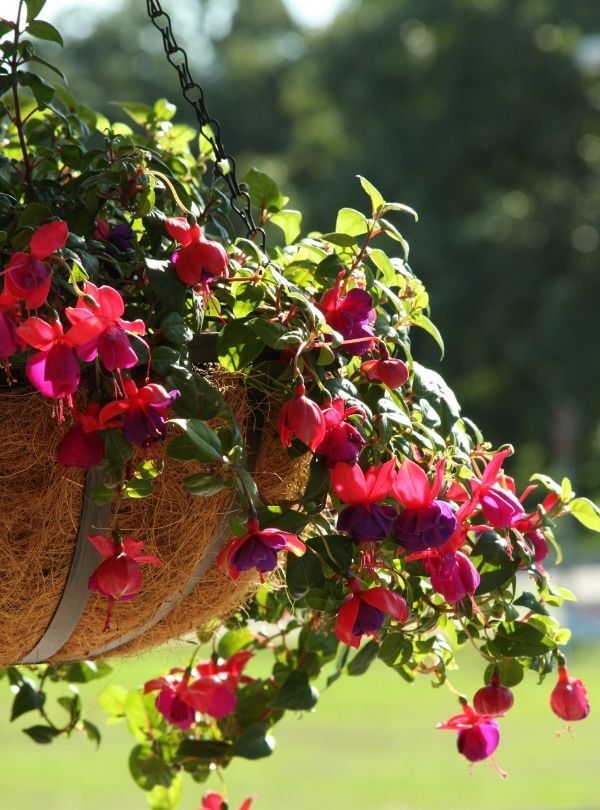
Enchanting is for sure the best adjective to describe fuchsias, with their hanging flowers with that original shape, with a long tubular set of petals in the middle, pistils and the stamen coming out of it and then a star of tepals, often of a different color, to crown it all.
They have a delicate exotic touch that however also suits a “temperate look”, even a forest setting…
Some, to be honest, are far too big for hanging baskets, but small varieties like the slim, magenta and deep purple ‘Ben Jammin’, or the broad flowered ‘Purple Rain’, or the candid but quite rebellious looking ‘White King’ reminiscent of a flying dove, will all fit into fairly small containers.
4. Vervain (Verbena Spp.)
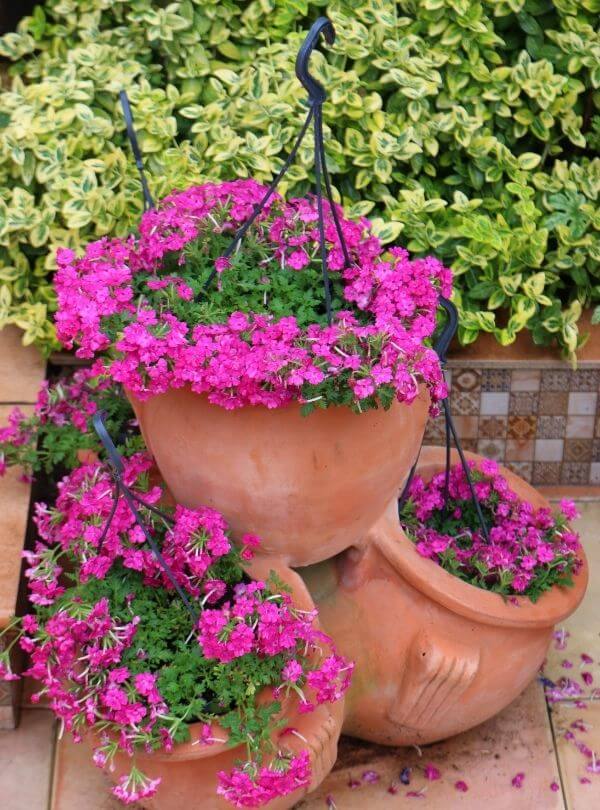
Vervain is another classic of hanging baskets; draping over the sides of containers with its clusters of scented flowers that can be white, pink, red, purple or blue, it will make a great show on your terrace or hanging in a gazebo.
With a blooming season that stretches from July to September, this perennial plant will give you an abundance of flowers all through the summer season, and the cascading,dark green stems with finely divided leaves will provide a backdrop with great texture and decorative value too.
5. Waterhyssop (Bacopa Monnieri)
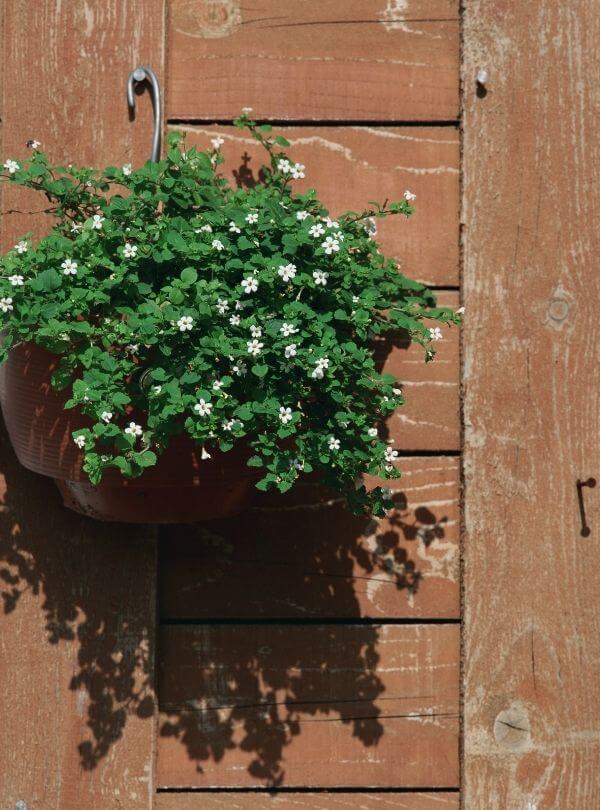
If you have a passion for white flowers and you also want to see them above your head, then you will fall in love waterhyssop, a perennial with trailing branches of fleshy green leaves similar to purslane’s dotted with innocent and sweet-looking flowers with five rounded petals.
This is a lesser known flowering plant for hanging baskets, but a perfect one if you are after an elegant and candid looking effect. And it also has great medical properties, in case…
6. Queen Of The Night Orchid Cactus (Epiphyllum Oxypetalum)
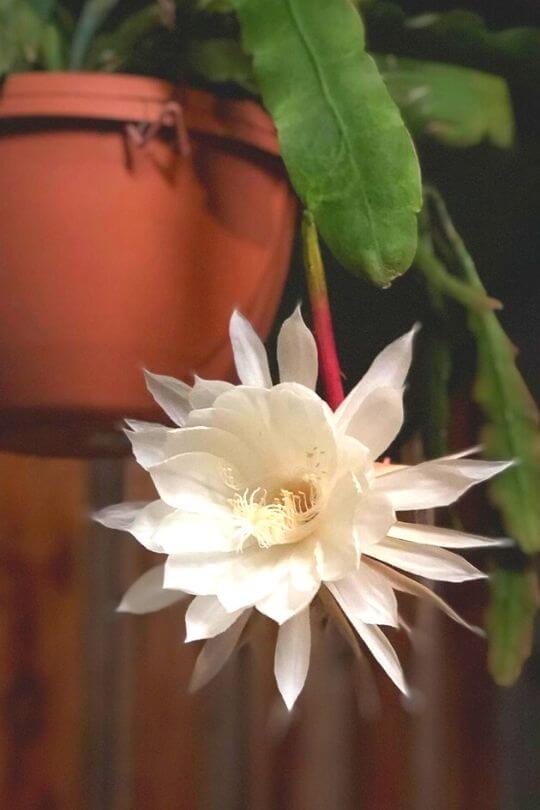
Following the white theme, but this time with a flowering cactus which puts on the most impressive floral display, queen of the night, an orchid cactus, is an elegant but exotic primadonna that can light up a whole room or terrace – a whole garden, in fact!
Its multi-petaled white flowers can be a foot long (30 cm!) and 10 inches wide (25 cm!), growing on scandent (or trailing) stems of two types, cylindrical at the base and then flat where the flowers bloom.
This is a large plant that can grow branches as long as 20 feet (6 meters), so, make sure you place the hanging basket very high up, on top of a tree, or tall wall…
7. Twinspur (Diascia Spp.)
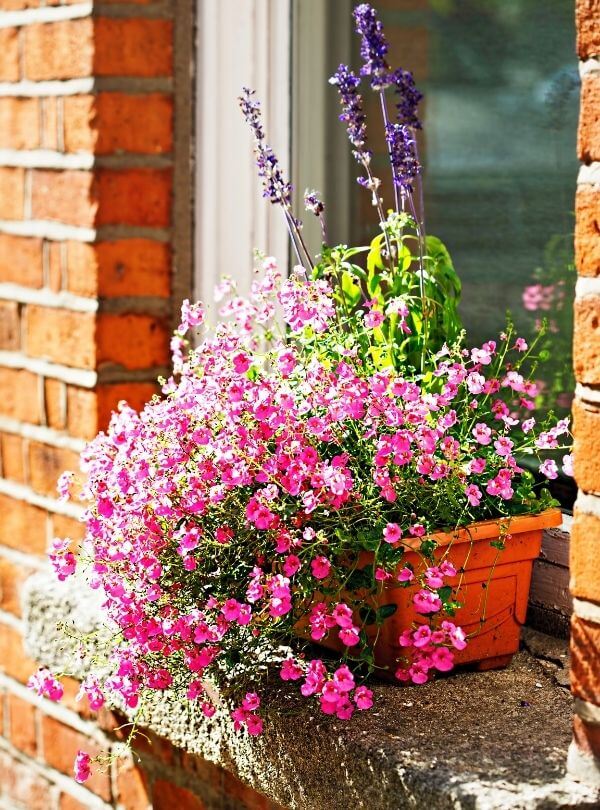
If you want your hanging baskets to convey delicate feelings, then twinspur has a palette of amazingly beautiful pastel colors: from white to light pink and apricot or sandstone orange.
While the flowers are showy and very abundant, so much so that they will cover the whole plant, the delicacy and elegance of this perennial beauty makes it ideal for traditional, romantic and ancient looking gardens and settings.
8. Trailing Lobelia (Lobelia Erinus)
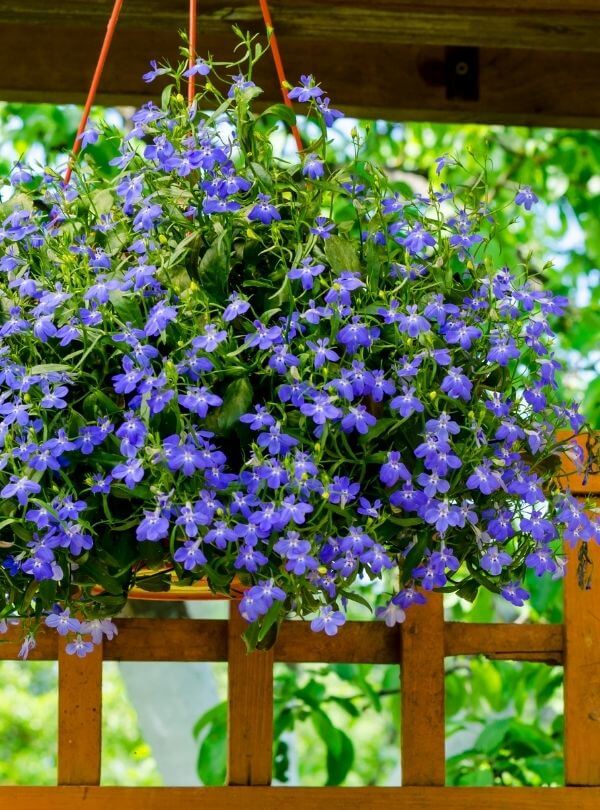
A flower you cannot resist falling in love with is trailing lobelia…
Small but very sweet looking, with its sea of originally shaped, vibrant purple blue flowers that will start filling your hanging baskets in spring and keep blooming till the first frost, this easy to grow and low maintenance plant can turn anybody into a child with its charming beauty.
Easy to grow from seed, generous and hardy, trailing lobelia can be grown as a perennial or as an annual, but keep in mind that it will give you abundant blooms in any case.
9. Rocktrumpet (Mandevilla Spp. Or Dipladenia Spp.)
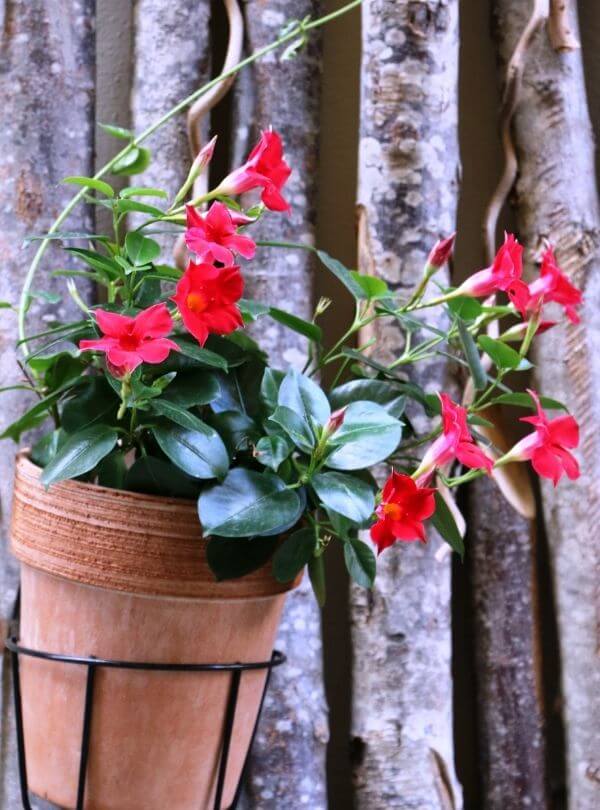
With extremely elegant vines, waxy deep green elliptical leaves but, above all, spectacular flowers that start tubular than open in large, brightly colored petals that appear to spiral slightly, rockyrunpet is becoming all the rage for hanging baskets in many countries.
The amazing gracefulness with which this perennial wonder from South and Central America spaces leaves and flowers, which keep blooming from late spring till fall, can turn any hanging basket into a work of art.
The flowers can be deep red, punk or white like in the RHS Award of Garden Merit winner white Dipladenia (Mandevilla boliviensis) or, rarely even blue.
10. Pansies (Viola Spp.)
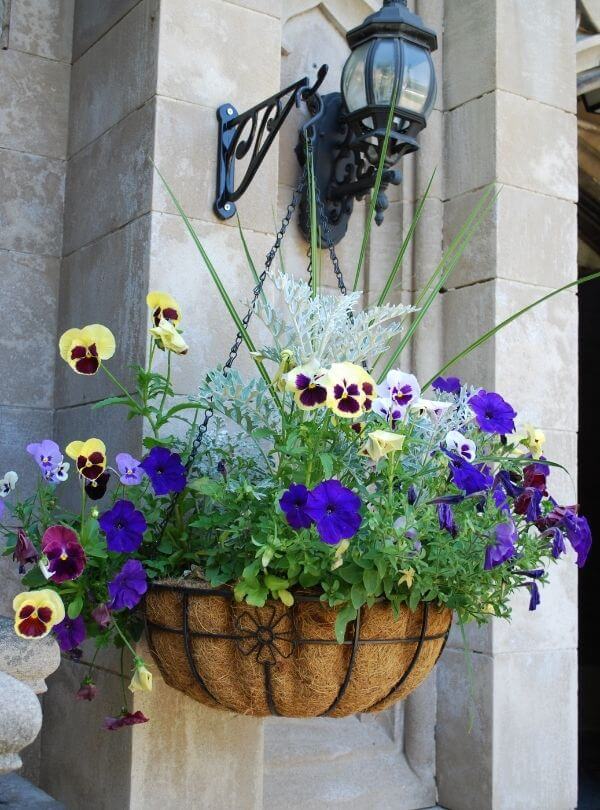
A favorite for all types of containers, including hanging baskets, is the well known pansy, which offers very generous blooms from early spring all through to fall and a range of colors that beggars belief…
In fact, the palette of this flower is huge, and the combinations are almost infinite, which means that if you are looking for variegated effect, or if you are after a particular hue or shade, you are sure that you can find it in one of the many varieties of this popular and always enchanting perennial.
11. Bolivian Begonia (Begonia Boliviensis)
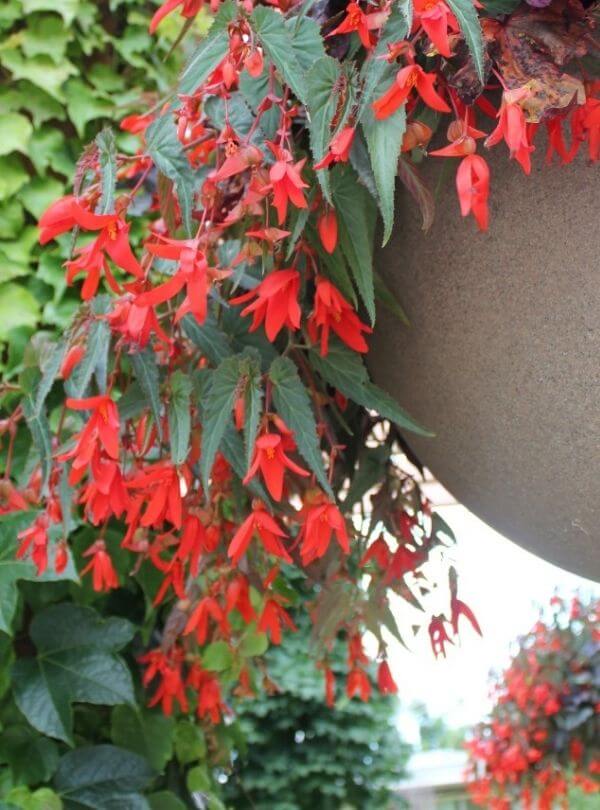
This beautiful variety of begonias is particularly suitable for hanging baskets because it has a partly trailing habit, so, the branches, with their large and decorative leaves but, above all, laden with a large number of brightly colored flowers, will drape over the sides of your containers and give them life…
The flowers of Bolivian begonia differ from other species because they look very delicate and they are not round and full; instead, you will have four petals hanging from the branch in an open bell shape, though you may be excused to confuse the, for butterfly at rest.
There are many cultivars, from white (‘Bossa Nova Pure White’) to peach (‘San Francisco’) magenta pink (‘Mistral Pink’) or the crimson red ‘Encanto Orange’, winner of the Award of Garden Merit by the Royal Horticultural Society.
All, however, have a very “old world” look that will be perfect in a traditional garden or decorative basket even in a shady place.
12. Flowering Maple (Abutilon Spp.)
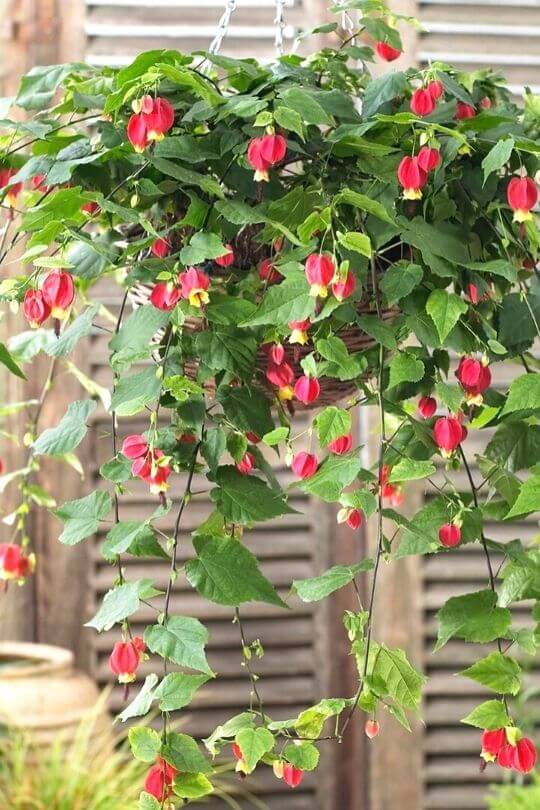
Now close your eyes and imagine your hanging basket with a bush of palmate leaves, a bit like those of maple trees and many brightly colored large, bowl shaped flowers hanging from its branches mouth down…
Now, look at the petals and you will see ribbed veins that give texture to these white, yellow, pink, orange or red petals, and at times, the veins will differ in color painting a wonderful pattern.
If you liked what you saw, then you may want to open your eyes and look for a garden center that sells flowering maple, a lesser known but stunning hanging basket plant!
13. Hot Water Plant (Achimenes Spp.)
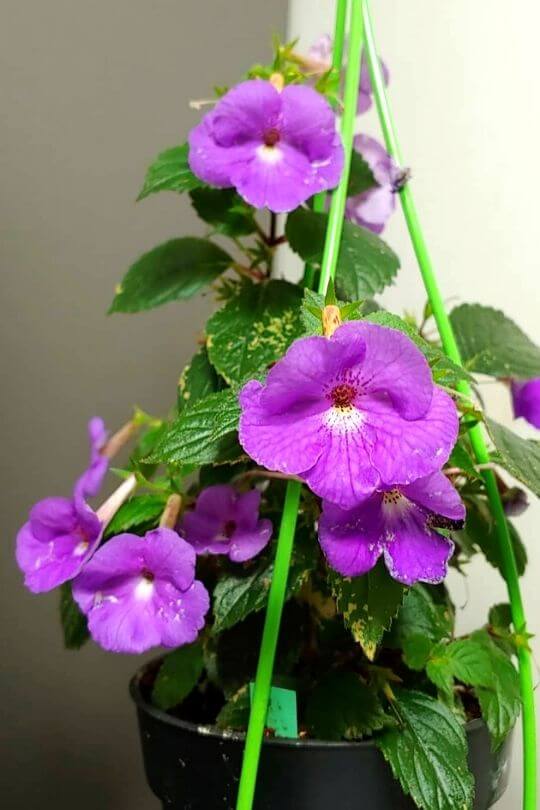
Also called “orchid pansy” because this flower is so showy, and related to both African violets and gloxinias, hot water plant is an impressive bloomer, that will keep going from late spring to fall, giving you flowers that start like long and thin tubes (a but like trumpets) but then suddenly open at the end with five large and round petals that clearly remind you of its close relatives.
Most typically purple violet, they can also be pink, white, white and purple red or yellow, so you have a wide choice of colors for your baskets.
14. Calibrachoa Million Bells (Calibrachoa Spp.)
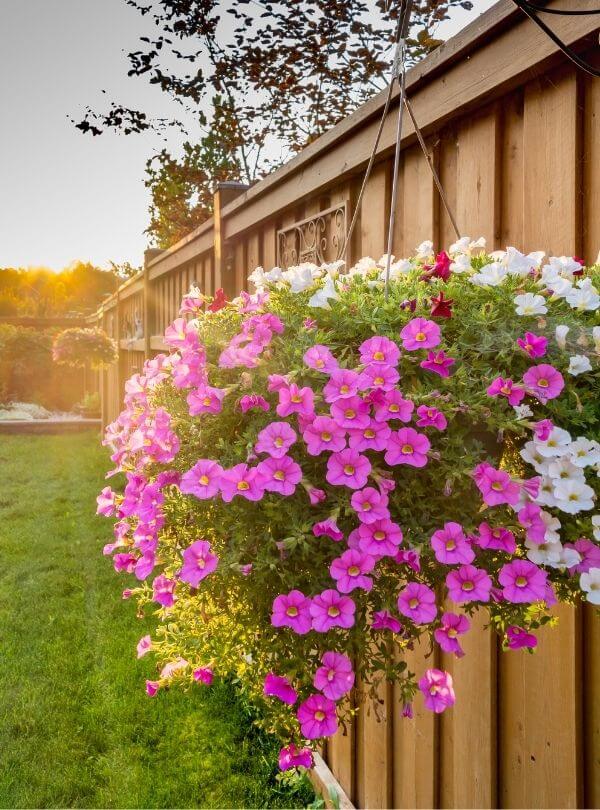
Five rounded petals, each divided by a central vein, and all joint for most of their length so that they look like one, at the end of a tubular base make calibrachoa also known as million bells, is a very soft and sweet cascading flowering plant to look at…
Well, not “a” flower because this plant will fill with a massive bloom from spring all the way to the first frost, so intense and abundant, in fact, that you will find it difficult to see the leaves of this trailing perennial… It’s not a chance that gardeners have nicknamed it “miracle petunia”!
And if you are picky about colors, then calibrachoa is available in white, yellow, orange, coral, pink, orange, blue, magenta, red, purple in combination.
In fact, this is an excellent plant if you want to have a multi-colored composition to bring vitality to your hanging baskets.
15. Impatiens (Impatiens Spp.)
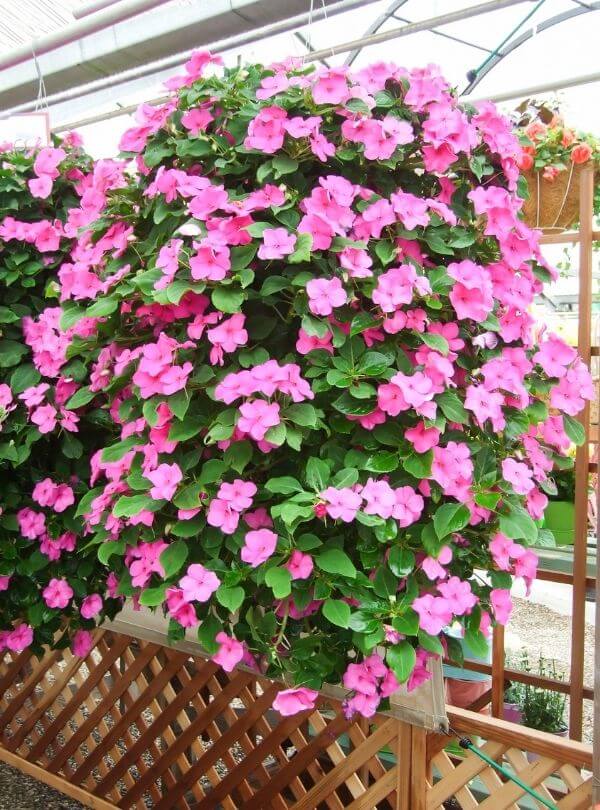
Fill your hanging baskets with many, round and cute flowers, soft in shape and delicate in appearance, looking up and out from deep green foliage!
All you need is one of the – hear, hear! – more than 1,000 varieties of impatiens.
This generous flower that you can have in absolutely all the colors of the rainbow will grace your containers with an abundance of flowers from late spring all the way to the first frost, and this is also why it has become very popular for public gardens all over the world.
Your Own Corner Of Heaven Full Of Flowers
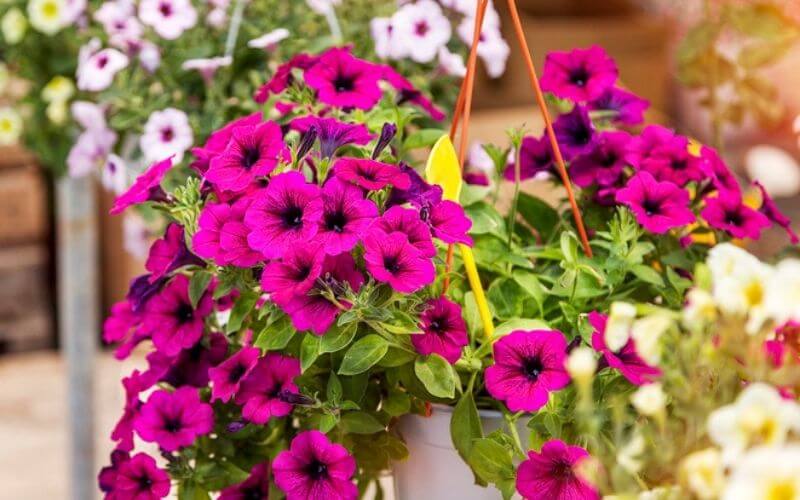
Have you noticed that almost all the plants we have met in this article are massive bloomers?
When you think hanging baskets, or when you see them in the streets, whether they are professionally made or grown with tender loving care by amateurs, what strikes you is how packed with colorful flowers they are, isn’t it?
With these flowers you too can achieve the same effect, and not for a week, nor even for a month, but with most of these beautiful flowers, for months on end or even most of the year…
True, you can always buy a ready made hanging basket, but nothing compares with making your own, and, to be honest, there are so many beautiful and easy to grow flowering plants that I can’t see any reason why you shouldn’t…
So, choose your basket, choose your flowers and grow your own corner of paradise in the sky!

Written By
Amber Noyes
Amber Noyes was born and raised in a suburban California town, San Mateo. She holds a master’s degree in horticulture from the University of California as well as a BS in Biology from the University of San Francisco. With experience working on an organic farm, water conservation research, farmers’ markets, and plant nursery, she understands what makes plants thrive and how we can better understand the connection between microclimate and plant health. When she’s not on the land, Amber loves informing people of new ideas/things related to gardening, especially organic gardening, houseplants, and growing plants in a small space.
